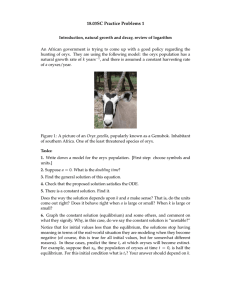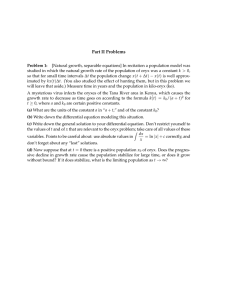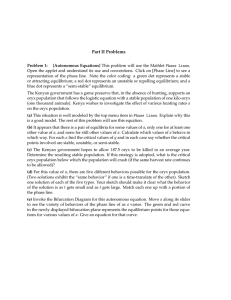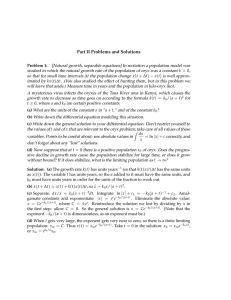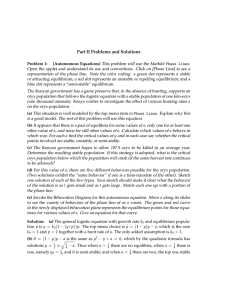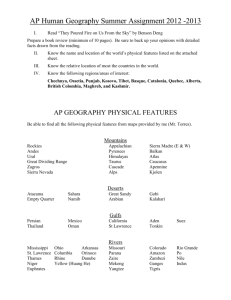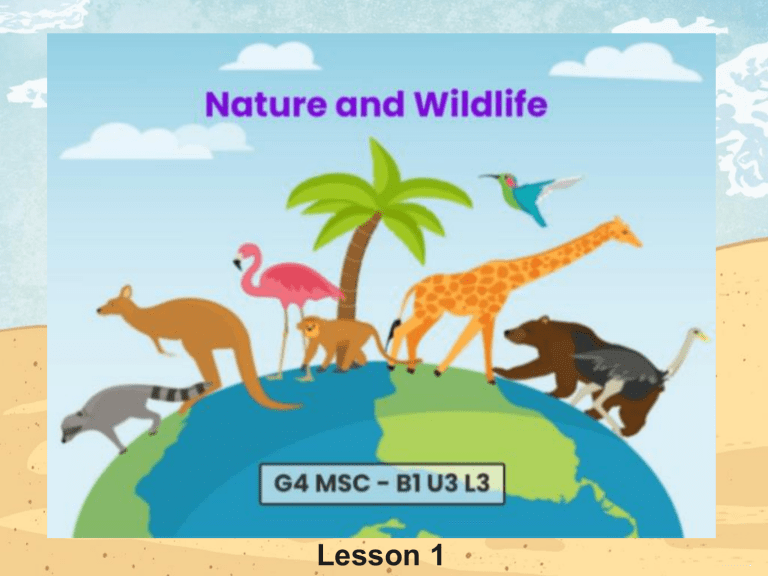
Lesson 1 LessonAim Objectives • To identify different climate zones based on pictures and previous knowledge. • To identify the different types of plants and animals on different climate zones. Success Success Criteria Criteria 1 Lorem ipsum dolor sit amet,by consectetur • IStatement can identify different climate zones looking atadipiscing pictures.elit. •• Statement 2 I can use previous knowledge to determine what types of • Sub statement animals are found in these zones • I can explain the existence of certain plants in these zones too. List at least three animals that live in each climate zone mentioned below: Tropics Subtropics Polar Amazon Rainforest of South America Some of the most beautiful and colorful animals and plants live in the tropics. In the Amazon rainforest it is hot and rainy all year. The hot weather and rain help the forest to grow. Some of the animals we can find there are monkeys, leopards, lions and colorful birds. The rainforest is important for humans because the plants release a lot of oxygen into the air. However, the rainforests are being cut down around the world and need our protection. Concept Check How much precipitation does an arid climate get? Lack of rain is what makes a climate arid. We find this climate in the subtropics. Areas having arid climate receive less than 35 cm of rain. Some deserts around the world receive less than 10 cm of rain in 10 years. The Atacama desert in Chile is known as the driest place on Earth. It averages 0.01 – 0.03 cm of rain each year. These areas are blasted with dry air most of the year, which causes the low precipitation. Vegetation and animals found in Arid climates To survive this climate plants must either require very little water or be able to store water. The plants often have long roots and thorns such as scrub bushes , grasses, aloe and cactus. Over thousands of years certain animals have adapted to the lack of water and extreme temperatures. Camels store water in their bloodstream and can drink 40 gallons of water in 10 minutes, allowing them to go for days without water.. Arabian oryx are desert antelopes. They are herbivores and have white coats to help them stay cool in the hot sun. Their special adaptation are their wide feet that help them stay on top on the sand. The sand cat feeds on small rodents, snakes and lizards. It is also able to live without drinking water and can sustain itself on the water it gets from its prey. It can also maintain its body’s moisture without feeling thirsty or hungry for a long time. North and South Pole Polar bears live in the North Pole. The walrus lives there too. A walrus is a large marine mammal. This means it lives in the water (in the Arctic Ocean) and it feeds its young with milk. Some other animals we can find in the North Pole are the Arctic fox, the snowy owl and the Arctic hare. The South Pole (Antarctica) is covered in ice, but it does have some plants: algae, moss and lichen. Penguins live in Antarctica. There are several types, such as emperor, adeli, and chinstrap penguins. Other animals that live in Antarctica include different types of seals, squid, whales, and different types of birds. The Arctic versus Antarctica - https://video.link/w/35kFc Let’s see if you can you answer these two questions: Self-assessment Key Features of the oryx long horns bright white coat to reflect sunlight brown markings on face eats roots of plants when food is scarce spade-like, large feet to walk on the sand drinks dew formed on plants and can go for weeks without a lot of water dark legs absorb heat at night Perfectly Adapted for Desert Life The Arabian oryx has many key adaptations that help it to successfully survive harsh, dry desert conditions. It has a white coat to reflect the sunlight of the day, while its dark legs help to absorb heat during cold desert mornings. The National Animal of the UAE Many people mistakenly think the national animal is the camel, or perhaps the horse. However, the Arabian oryx is actually the national animal of the UAE. A picture of the Arabian oryx even features on the Dh50 currency notes. Arabian oryx lived in large numbers in rocky desert, sand dunes and dry habitats across the Arabian Peninsula until the early 20th Century, when poaching and destruction of their natural habitat caused their extinction in this location. The National Animal of the UAE By the 1960s, the animals scattered into small groups in southern parts of the Arabian Peninsula and became extinct in the wild in 1972. Thanks to a conservation and reintroduction programme initiated by the late Sheikh, Zayed bin Sultan Al Nahyan, the UAE is today home to the largest population of Arabian oryx in the world, with more than 6200 individuals. What is an Arabian Oryx? The Arabian oryx is an antelope that is highly specialised for its harsh desert environment. It has a bright white coat. Its hooves are splayed and shovel-like. Its legs are brown in colour, with white bands on the ankles. There are brown markings on its face, the bridge of its nose, its cheeks and also in a triangular patch on its forehead. What is an Arabian Oryx? Both males and females have horns, which are so symmetrical that if viewed from the side profile, the two horns look like one. Some say that the legend of the unicorn may have started with the Arabian oryx because of this likeness. Horns can grow to from 22 to 58 inches in length. The Arabian oryx is a herbivore and usually prefers to inhabit areas around the edges of sandy deserts, where a diverse and ample amount of vegetation of shrubs, trees and grasses can be found. Young Oryx A female oryx gives birth to a single calf. Calves weigh around 10 kilograms at birth. A newborn calf stands and walks an hour after being born. The calf is hidden away for two to three weeks, with the mother visiting 2–4 times daily to feed it. Calves are brown at birth and their markings develop when they are old enough to join the herd. The life span of an oryx can be up to 20 years in preferred grazing conditions, however threat to their habitat can make this much shorter. Perfectly Adapted for Desert Life It can sense rain over long distances and so can find fresh grasses and plants, and will even eat roots when no other forage is available. It feeds during dawn and late afternoon, resting in shaded areas during the mid-day heat. As for water, the Arabian oryx can go for days (and sometimes even weeks), without a significant drink, finding enough water by drinking dew that has formed on the plants it eats or from the water content of the plants themselves. Key Facts Region: Arabian peninsula Habitat: desert and semi desert, steppe and savanna Food: grasses, herbs, fruit, roots and melons Size: 3 to 4 feet tall, approximately 300 pounds Babies: newborns calves stand and walk an hour after being born Conservation Efforts The late Sheikh, Zayed bin Sultan Al Nahyan, Founder of the UAE, took a personal interest in the Arabian oryx. He was one of the first conservationists to notice the alarming rate of decrease in its numbers, and in 1968, he launched a successful conservation programme of Arabian oryx in Al Ain. In 1978, four oryx (2 males, 2 females) were transferred from Al Ain to Sir Bani Yas Island for breeding. Today, Sir Bani Yas Island accommodates more than 731 Arabian oryx and the population all over the UAE is flourishing. Photo courtesy of (Ismail.alghussein@https://commons.wikimedia.org/wiki/File:Sir_Bani_Yas_Island_Panorama.jpg) - granted under creative commons licence – attribution Reintroduction into the Wild The next phase for the conservation of the Arabian oryx was for it to be reintroduced into the wild. Following in the footsteps of his father, The Sheikh Mohammed bin Zayed Arabian Oryx Reintroduction Programme started in 2007. It aimed to reintroduce the Arabian oryx into large sanctuaries within the areas they lived during the past and create a self-contained population that could roam freely in their natural habitat. The five-year plan involved 500 animals to be released over the five-year period, with 100 oryx each year.
